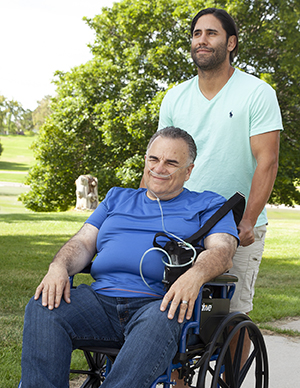Hospice: Understanding and Caring for Shortness of Breath (Dyspnea)
Shortness of breath or breathlessness (dyspnea) is common in people with serious or advanced illness. It makes breathing difficult and uncomfortable. And it can cause a lot suffering. Families may be affected as well as they watch their loved one struggle to breathe. Dyspnea can be distressing for both the people who have it and their families. So it’s important to understand the scope of this symptom and the ways it can be treated.
What are common causes of dyspnea?
There are many causes of dyspnea. It can occur due to lung problems such as chronic obstructive pulmonary disease (COPD). It can be a symptom of other health problems, such as heart disease, cancer, or neuromuscular disease. And it may occur as any life-limiting illness gets worse. Dyspnea often causes anxiety. This then makes breathing problems worse.
How is dyspnea treated?
The main goal of treatment is to help the person breathe more comfortably. To do this, medicines and other therapies are often used.
Medicines
Medicines can include:
-
Oxygen therapy. This treatment helps improve breathing. It may be prescribed if tests show low oxygen in the blood. It may also be prescribed if it adds to the person’s comfort.
-
Opioids. These medicines are most often used to ease pain. But they can also help ease shortness of breath.
-
Other medicines. These can include medicines to relieve certain problems that can occur with dyspnea, such as anxiety.
Other therapies
Other therapies can include:
-
Breathing exercises. People are often taught pursed-lip breathing and diaphragmatic breathing to help them breathe better. These methods can also help ease dyspnea and anxiety.
-
Ways to save energy. People are taught the best ways to move and use their bodies. This helps them save their strength. And it makes breathing easier when doing normal tasks.
-
Body positioning. For some people, sitting upright may increase comfort and improve breathing. It may also help to raise the head of the bed when resting and sleeping.
-
Relaxation. This can help reduce stress and anxiety, which can make dyspnea worse. Some common methods include meditation and visualization. Simple activities can also help people relax and be distracted from shortness of breath. These include doing things, such as reading a book, watching a movie, or listening to music.
-
Breathing devices. These can be helpful in opening a person’s airways to reduce breathing problems. A respiratory therapist can help decide if a breathing device would be helpful.
How can loved ones help?
A person’s loved ones often aren’t sure what to do to help relieve breathing problems. Start by asking the healthcare provider for advice on how to help. These tips may help as well:
-
Keep your loved one comfortable and safe:
-
Maintain a cool temperature in the person's room. Lower the thermostat, or place a fan where it can blow gently on the person’s cheek. Keep a window open to let in fresh air, if the weather is good.
-
Help your loved one conserve energy. Put items,, such as medicines, drinks, remote controls, books, and walking aids within reach.
-
If the person uses oxygen, keep sources of flame away from where the oxygen unit is stored. Check that the oxygen unit is turned off when it's not in use. And be sure to keep a fire extinguisher in the house. Don't let anyone smoke in your home. Smoking inside a home while supplemental oxygen is in use increases the risk of fire.
-
Don’t let breathing trouble isolate your loved one. Spend time with them doing normal activities. Eat meals, watch movies, and go outdoors with your loved one.
-
Provide calm support. Try to stay calm and relaxed around your loved one. People can often sense when family members and caregivers are worried about them. This can add to their anxiety, and make their dyspnea worse.

© 2000-2024 The StayWell Company, LLC. All rights reserved. This information is not intended as a substitute for professional medical care. Always follow your healthcare professional's instructions.